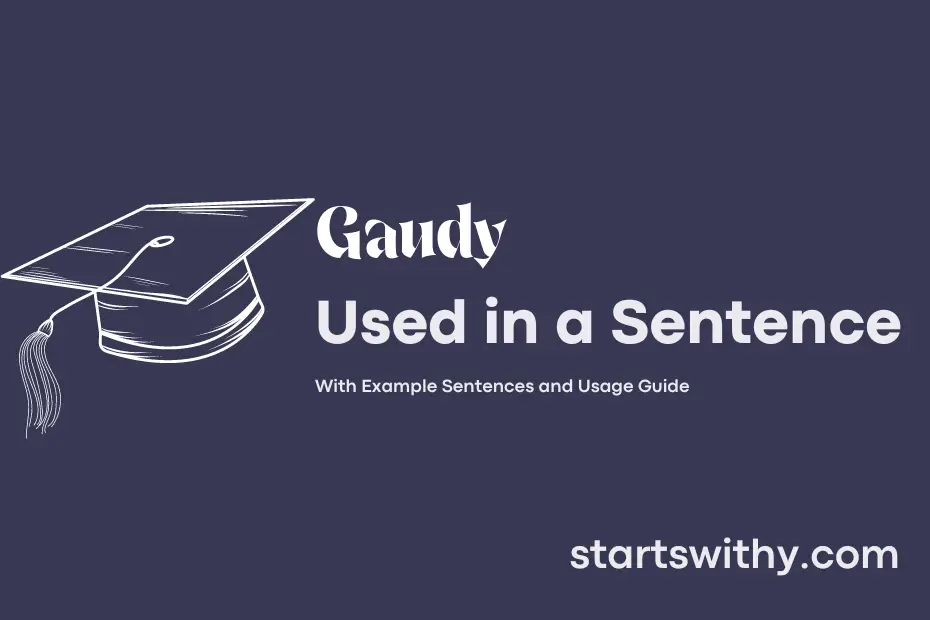Have you ever come across a sentence that was so flamboyantly decorated with colorful and showy language that it seemed almost obnoxiously flashy? This type of excessively ornate and ostentatious writing can be aptly described as “gaudy.”
When a sentence is described as gaudy, it often means that it is overly ornamental or flashy, drawing attention to itself with excessive decoration or elaboration. This can result in a lack of subtlety or elegance in the writing, instead opting for a brash and showy style that may distract from the actual substance of the sentence.
7 Examples Of Gaudy Used In a Sentence For Kids
- Gaudy colors are so bright and flashy!
- I love wearing gaudy clothes for festivals.
- The peacock has such gaudy feathers.
- My gaudy bangles jingle when I move.
- The gaudy flowers make me smile.
- I painted a gaudy rainbow in my drawing.
- Gaudy decorations make the party fun.
14 Sentences with Gaudy Examples
- Gaudy posters are plastered all over campus to promote the upcoming music fest.
- Some students prefer to wear gaudy and vibrant clothes to stand out in the crowd.
- The decorations at the college party were so gaudy that they hurt my eyes.
- The group project presentation was criticized for its gaudy design and color scheme.
- The bulletin board was filled with gaudy flyers advertising various club meetings.
- The fashion show at college featured models strutting down the runway in gaudy outfits.
- The campus bookstore sells a variety of gaudy stationery items to appeal to students.
- Anushka felt out of place wearing gaudy makeup to a formal academic event.
- The auditorium was adorned with gaudy curtains for the drama society’s performance.
- Vishal’s laptop bag stood out with its gaudy neon green color among the sea of black bags.
- The mural painted on the college wall was too gaudy for some students’ tastes.
- Aanya’s room in the hostel was filled with gaudy fairy lights and colorful tapestries.
- The college canteen had a reputation for serving gaudy and overly sweet desserts.
- Priya’s presentation slides were criticized for their gaudy use of animations and clip art.
How To Use Gaudy in Sentences?
To use Gaudy in a sentence, you can follow these simple steps:
-
Understanding the Meaning: Gaudy means extravagantly bright or showy, typically so as to be tasteless. It is often used to describe something that is overly flashy or ornate.
-
Selecting an Object: Think of something that fits the description of being excessively bright or showy. This could be an outfit, a piece of jewelry, a room decoration, or any other object that stands out for its flashy appearance.
-
Forming the Sentence: Try to incorporate Gaudy in your sentence to describe the object you have chosen. For example, “She wore a gaudy dress covered in sequins and feathers.” This sentence clearly conveys the idea of an overly flashy and tasteless outfit.
-
Contextual Usage: Consider the context in which you are using the word Gaudy. Make sure it fits well within the overall message or theme of your sentence.
-
Practice: To become more comfortable using Gaudy in sentences, try practicing with different objects and scenarios. This will help you become more familiar with the word and its usage.
By following these steps and practicing regularly, you will be able to effectively incorporate Gaudy into your vocabulary and writing.
Conclusion
In conclusion, sentences with gaudy descriptors are vivid and flashy, often using extravagant and over-the-top language to evoke strong visual images. These sentences tend to be attention-grabbing and colorful, drawing the reader’s focus to the flamboyant and ostentatious details of the described subject. While gaudy sentences can be entertaining and engaging, they are best used sparingly to avoid overwhelming the reader with excessive ornamentation and unnecessary embellishments.
Overall, sentences with gaudy language can be a powerful tool for creative writing, adding flair and vibrancy to descriptions. However, it is important to strike a balance and use these sentences judiciously to enhance rather than overshadow the main message or theme of the writing.



